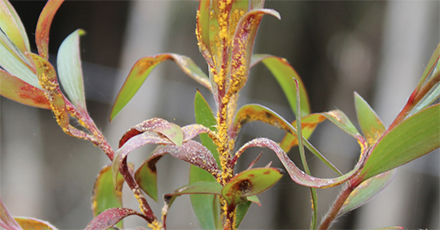Leading experts have come together to share their research as part of a national action plan to combat the highly invasive fungal disease myrtle rust. Acting Chief Environmental Biosecurity Officer Elyse Herrald-Woods said the symposium offered the opportunity for experts across government, industry and the community sector to share their knowledge, prepare strategies, and discuss the latest research. Source: Timberbiz
“Since myrtle rust was first detected in New South Wales in April 2010 it has spread across the eastern Australian landscape,” Ms Herrald-Woods said. “Myrtle rust affects the plant family Myrtaceae, which makes up 10% of Australia’s native flora and includes eucalypts, tea-trees, paperbarks, and lillypillies – species that are not only found in our parks and gardens but are integral to the health of many of our country’s ecosystems.
“Currently, it is known to infect 382 native plant species or sub-species. For this reason, it is listed on both the National Priority List of Exotic Environmental Pests, Weeds and Diseases, where it is a higher risk plant disease, and the National Priority Plant Pest list, where it is number 11.
“Events like the Myrtle Rust National Symposium are a chance for the top experts in their field to share their research and knowledge on preventing the spread of myrtle rust further into our unique environment.
“Equally importantly, local land managers, Indigenous Rangers and community groups who are putting in the hard yards to understand and manage the impacts of this disease were also present to share their findings.
“Capturing all this information in a range of knowledge products for use by those groups and individuals fighting the spread and impact of myrtle must is a priority outcome of the Symposium for the Australian Government.”
The government continues to engage with researchers, experts, land managers and community groups on the implementation of priorities identified in the recently released Myrtle Rust National Action Plan, which was designed to create, co-ordinate and adapt a long-term, national, environmental response to myrtle rust. Enforcing strict biosecurity controls at the border to prevent the arrival of new strains of myrtle rust remains a priority.
The Symposium also helps build the capacity of the national biosecurity and environmental management system to manage the risks posed by exotic strains of myrtle rust that have not yet reached our shores.
This is in addition to the investment the Australian Government continues to make in those preventative actions for products and pathways that may be contaminated by exotic strains of Myrtle Rust, to reduce the risk of these strains arriving in Australia in the first place.
The Symposium was held in Ballina, New South Wales, and was hosted by the by the Australian Plant Biosecurity Science Foundation who were co-funded by the Australian Government’s Environmental Biosecurity Project Fund, the Threatened Species Recovery Hub, the New South Wales Government’s Saving Our Species program, and the Biosecurity Collective.
If you suspect you have discovered myrtle rust on your property, call the Exotic Plant Pest Hotline on 1800 084 881. Visit the Plant Biosecurity Science Foundation website to learn more about the Myrtle Rust National Symposium and to view the Myrtle Rust National Action Plan.
Visit the department’s website to find out more about the listing of exotic strains of myrtle rust on the National Priority List of Exotic Environmental Pests, Weeds and Diseases and the National Priority Plant Pest list.






